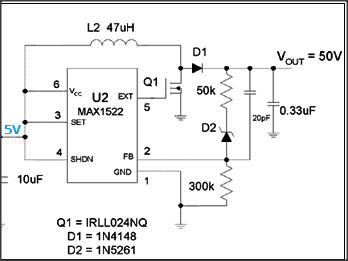Ok, so I need to generate 50 V from 5 V, with a load of 0 to 20 mA, for a mass-produced device. There are simple boost converter circuits like this LT3467 example:

but it seems these are limited by the maximum voltage on SW (in this case 42 V). Are there any that can go directly to 50 V?
If not, there seem to be several possibilities:
- external FET with higher voltage rating
- charge pump after the boost converter
- autotransformer instead of inductor
1: Is adding an external FET sufficient to get up this high? It seems like it, though I don't know how much current this can supply:

2: Can also use a charge pump / voltage doubler after the boost converter, without an external FET, something like this (with the FET built into the boost converter IC):

Then the SW voltage can be half (or less) of the output voltage. One advantage of this is that it produces intermediate voltages, which might be useful. In this case, should the feedback be before or after the voltage doubler?
3: Other examples show an autotransformer replacing the inductor, and no external FET:

So, uh, what's the simplest/cheapest/best way to do this? What are the advantages and disadvantages of each solution? Which external components cost the most? Which solution can supply the highest current? Which has the best output regulation?
